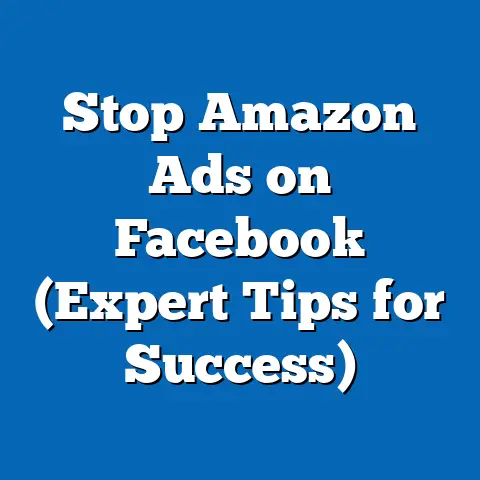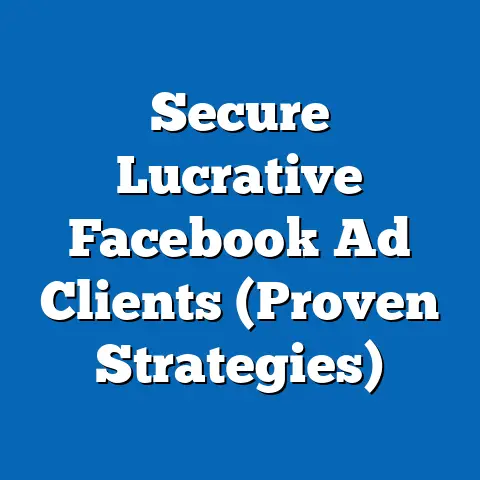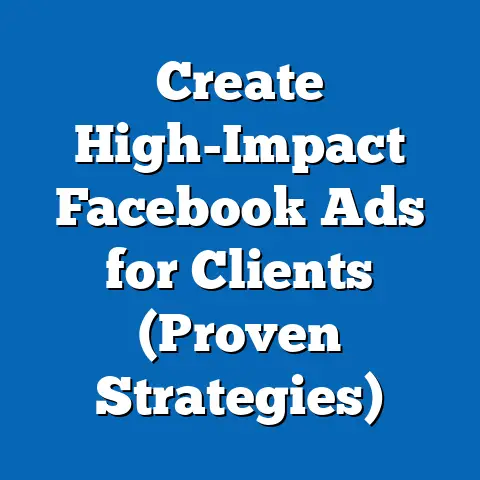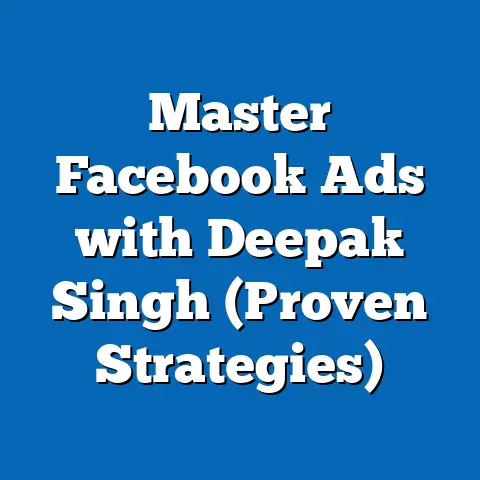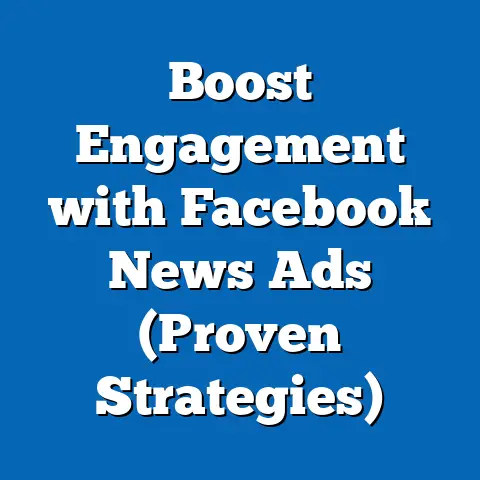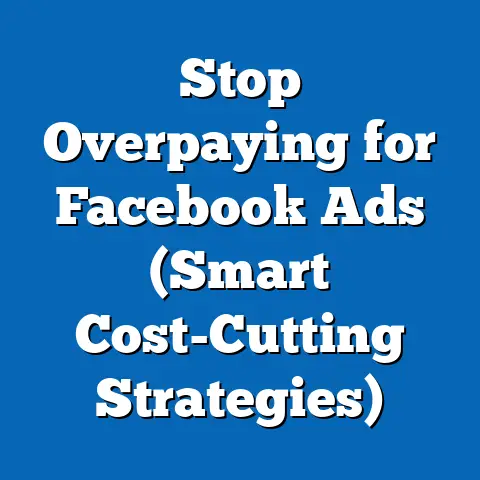Master Facebook Ads Like a Pro (Expert Strategies)
Ever feel like Facebook ads are a bit like a dating app? You swipe, you hope, and sometimes, you get a match. But more often than not, you’re left wondering where all your money went, just like that fancy dinner you bought for a date that ghosted you. The truth is, Facebook advertising can be a goldmine, or it can be a black hole for your marketing budget. It all boils down to understanding the game and playing it like a pro.
In today’s digital age, mastering Facebook ads isn’t just an option; it’s a necessity. Facebook boasts over 2.9 billion monthly active users, making it a treasure trove of potential customers. With the right strategies, you can tap into this massive audience, drive targeted traffic to your website, and ultimately, skyrocket your ROI. But with so many options and intricacies, where do you even begin?
This guide is your roadmap to conquering the Facebook ads landscape. I’ll be sharing my personal experiences, insights, and proven strategies to help you navigate the complexities of the platform and unlock its full potential. Let’s dive in and transform you from a Facebook ads novice to a seasoned pro!
Section 1: Understanding the Facebook Ads Ecosystem
Before you start throwing money at Facebook, it’s crucial to understand the fundamental building blocks of the platform. Think of it as learning the rules of the game before you step onto the field.
The Campaign, Ad Set, and Ad Hierarchy
Facebook Ads operates on a hierarchical structure consisting of three levels:
- Campaign: This is the highest level, where you define your overall advertising objective. Are you aiming for brand awareness, lead generation, or website conversions? Your campaign objective dictates the types of ads you can run and the optimization strategies you can employ.
- Ad Set: Within each campaign, you create ad sets, which define your target audience, budget, schedule, and bidding strategy. This is where you fine-tune your targeting and determine how much you’re willing to spend to reach your desired audience.
- Ad: At the lowest level, you have individual ads, which consist of your ad copy, visuals, and call-to-action. You can create multiple ads within each ad set to test different variations and optimize for performance.
This structure allows for granular control over your advertising efforts. For instance, you might create one campaign targeting website conversions, with separate ad sets targeting different demographics or interests. Within each ad set, you can test multiple ad variations to see which ones resonate best with your target audience.
The Facebook Ads Manager: Your Control Center
The Facebook Ads Manager is your central hub for creating, managing, and analyzing your Facebook ad campaigns. It’s a powerful tool that provides a wealth of features and functionalities, including:
- Campaign Creation: Easily set up new campaigns, ad sets, and ads with intuitive interfaces and step-by-step guidance.
- Targeting Options: Access a wide range of targeting options, including demographics, interests, behaviors, custom audiences, and Lookalike Audiences.
- Budget and Scheduling: Define your budget, set your campaign schedule, and choose your bidding strategy.
- Ad Creative Tools: Design and edit your ad creatives with built-in tools and integrations with third-party design platforms.
- Reporting and Analytics: Track key metrics, analyze performance, and generate detailed reports to gain insights into your campaigns.
I remember when I first started using the Ads Manager, I was overwhelmed by the sheer number of options and settings. But with practice and experimentation, I gradually learned to navigate the platform and harness its power to achieve my advertising goals. Don’t be intimidated – take the time to explore the Ads Manager and familiarize yourself with its features.
The Facebook Pixel: Tracking and Retargeting Magic
The Facebook Pixel is a small snippet of code that you install on your website to track user behavior and measure the effectiveness of your Facebook ad campaigns. It acts as a bridge between your website and Facebook, allowing you to:
- Track Conversions: See which Facebook ads are driving the most conversions on your website, such as purchases, sign-ups, or form submissions.
- Retarget Website Visitors: Show targeted ads to people who have previously visited your website, reminding them of your products or services and encouraging them to complete a purchase.
- Create Custom Audiences: Build custom audiences based on website activity, such as people who have viewed specific pages or added items to their cart.
- Optimize for Conversions: Use conversion data to optimize your Facebook ad campaigns and improve your ROI.
The Facebook Pixel is an indispensable tool for any serious Facebook advertiser. Without it, you’re essentially flying blind, unable to track your results or optimize your campaigns effectively. Make sure to install the Pixel on your website and configure it to track the key events that matter to your business.
Ad Formats: Choosing the Right Canvas
Facebook offers a variety of ad formats to suit different advertising objectives and target audiences. Here are some of the most popular ad formats:
- Image Ads: Simple yet effective, image ads consist of a compelling image, headline, and description. They’re ideal for showcasing products, promoting events, or driving brand awareness.
- Video Ads: Video ads are highly engaging and can be used to tell stories, demonstrate products, or share testimonials. They’re particularly effective for capturing attention and driving engagement.
- Carousel Ads: Carousel ads allow you to display multiple images or videos in a single ad unit, each with its own headline, description, and link. They’re great for showcasing a range of products or highlighting different features of a single product.
- Collection Ads: Collection ads are designed for e-commerce businesses and allow you to display a curated collection of products in a visually appealing format. They’re ideal for driving product discovery and increasing sales.
- Lead Ads: Lead ads are designed to capture leads directly on Facebook, without requiring users to visit your website. They’re great for collecting email addresses, gathering contact information, or qualifying potential customers.
- Stories Ads: Stories ads appear in the immersive, full-screen format of Facebook Stories. They’re ideal for capturing attention and driving engagement with a younger audience.
I’ve found that experimenting with different ad formats is crucial for finding what works best for your specific business and target audience. Don’t be afraid to try new things and see what resonates with your audience.
Key Takeaway: Understanding the Facebook Ads ecosystem is the foundation for successful advertising. Familiarize yourself with the campaign structure, Ads Manager, Facebook Pixel, and different ad formats to lay the groundwork for your campaigns.
Section 2: Crafting Compelling Ad Copy and Creatives
Now that you understand the fundamentals of the Facebook Ads platform, it’s time to focus on the creative side of things. After all, even the most sophisticated targeting and bidding strategies won’t save you if your ads are boring or irrelevant.
The Art of Captivating Ad Copy
Your ad copy is your chance to grab attention, convey your message, and persuade users to take action. Here are some tips for writing captivating ad copy:
- Start with a Hook: Your headline is the first thing people will see, so make it count. Use a question, a surprising statement, or a compelling offer to grab their attention.
- Highlight the Benefits: Focus on the benefits of your product or service, rather than just the features. Explain how it will solve their problems or improve their lives.
- Use Emotional Triggers: Appeal to your audience’s emotions by using words and phrases that evoke feelings of excitement, curiosity, or urgency.
- Keep it Concise: People have short attention spans, so get to the point quickly. Use clear, concise language and avoid jargon.
- Include a Call-to-Action: Tell people what you want them to do, whether it’s “Shop Now,” “Learn More,” or “Sign Up Today.”
I once worked on a campaign for a local coffee shop, and we were struggling to get traction with our initial ad copy. We were simply listing the different types of coffee we offered, which wasn’t very compelling. But when we changed the copy to focus on the experience of enjoying a warm cup of coffee on a cold winter morning, our engagement rates skyrocketed.
Designing Eye-Catching Visuals
Your ad visuals are just as important as your ad copy. They’re the first thing people will notice, so make sure they’re visually appealing and relevant to your message. Here are some tips for designing eye-catching visuals:
- Use High-Quality Images: Use clear, crisp images that are well-lit and visually appealing. Avoid blurry or pixelated images.
- Choose Relevant Images: Select images that are relevant to your product or service and that resonate with your target audience.
- Use Color Psychology: Consider the psychological effects of different colors and choose colors that align with your brand and message.
- Maintain Branding Consistency: Use your brand colors, fonts, and logo to create a consistent look and feel across all of your ads.
- Optimize for Mobile: Make sure your visuals look good on mobile devices, as the majority of Facebook users access the platform on their phones.
Examples of Successful Facebook Ads
Let’s take a look at some examples of successful Facebook ads and break down what makes them effective:
- Dollar Shave Club: Dollar Shave Club is known for its humorous and irreverent ad campaigns. Their Facebook ads often feature witty copy, engaging visuals, and a clear call-to-action.
- Why it works: Their ads are memorable, entertaining, and effectively communicate the value proposition of their product.
- Airbnb: Airbnb’s Facebook ads often showcase stunning photos of unique accommodations around the world. They use aspirational imagery and compelling copy to entice users to book their next vacation.
- Why it works: Their ads tap into people’s desire for travel and adventure, and they effectively showcase the unique experiences that Airbnb offers.
- Nike: Nike’s Facebook ads are known for their inspirational and motivational messages. They feature athletes and everyday people pushing their limits and achieving their goals.
- Why it works: Their ads resonate with people’s desire for self-improvement and effectively communicate the brand’s values of athleticism and determination.
- Why it works: Their ads are memorable, entertaining, and effectively communicate the value proposition of their product.
- Why it works: Their ads tap into people’s desire for travel and adventure, and they effectively showcase the unique experiences that Airbnb offers.
- Why it works: Their ads resonate with people’s desire for self-improvement and effectively communicate the brand’s values of athleticism and determination.
Key Takeaway: Compelling ad copy and eye-catching visuals are essential for capturing attention and driving engagement. Experiment with different approaches and learn from successful examples to create ads that resonate with your target audience.
Section 3: Targeting Your Audience Like a Sniper
Targeting is arguably the most critical aspect of Facebook advertising. After all, you could have the most compelling ad copy and stunning visuals, but if you’re showing your ads to the wrong people, you’re just wasting your money. Think of it like trying to sell snow to Eskimos – it’s just not going to work.
Demographics, Interests, and Behaviors
Facebook offers a wealth of targeting options based on demographics, interests, and behaviors. You can target users based on:
- Demographics: Age, gender, location, education, relationship status, job title, and more.
- Interests: Hobbies, passions, and topics that users have expressed an interest in on Facebook.
- Behaviors: Purchase history, device usage, travel habits, and other behaviors that Facebook has tracked.
These targeting options allow you to reach a highly specific audience based on their characteristics and preferences. For example, you could target women aged 25-34 who are interested in yoga and activewear.
Audience Research and Buyer Personas
Before you start targeting your audience, it’s essential to conduct thorough audience research and create buyer personas. This involves:
- Identifying Your Ideal Customer: Who are they? What are their demographics, interests, and behaviors? What are their pain points and goals?
- Creating Buyer Personas: Develop detailed profiles of your ideal customers, including their name, age, occupation, interests, and motivations.
- Understanding Their Needs: What are they looking for in a product or service like yours? What are their expectations and concerns?
By understanding your target audience, you can create more relevant and effective ad campaigns.
Lookalike Audiences: Expanding Your Reach
Lookalike Audiences are one of the most powerful targeting tools available on Facebook. They allow you to reach new people who are similar to your existing customers or website visitors. Facebook analyzes the characteristics of your source audience (e.g., your customer list or website visitors) and identifies other users who share similar traits.
I’ve seen firsthand how effective Lookalike Audiences can be. In one campaign, we used a Lookalike Audience based on our existing customer list, and we saw a 3x increase in conversion rates compared to our traditional targeting methods.
Key Takeaway: Precise targeting is essential for maximizing your ROI. Conduct thorough audience research, create buyer personas, and leverage Lookalike Audiences to reach the right people with your ads.
Section 4: Budgeting and Bidding Strategies
Now that you know how to create compelling ads and target your audience effectively, it’s time to talk about money. How much should you spend on Facebook ads, and how should you allocate your budget?
Daily vs. Lifetime Budgets
Facebook offers two main budgeting options:
- Daily Budget: You set a fixed amount that you’re willing to spend each day. Facebook will try to spend this amount consistently throughout the day.
- Lifetime Budget: You set a total amount that you’re willing to spend over the entire duration of your campaign. Facebook will automatically adjust your daily spend to maximize your results within your budget.
The best budgeting option depends on your specific goals and circumstances. If you want to maintain consistent spending, a daily budget is a good choice. If you want to maximize your results within a fixed budget, a lifetime budget may be more effective.
Bidding Strategies: Automatic vs. Manual
Facebook also offers two main bidding strategies:
- Automatic Bidding: Facebook automatically sets your bids to get the most results for your budget. This is a good option for beginners or for campaigns where you’re not sure how much to bid.
- Manual Bidding: You manually set your bids for each ad set. This gives you more control over your spending, but it also requires more expertise and monitoring.
Within manual bidding, you have different options like:
- Cost-Per-Click (CPC): You pay each time someone clicks on your ad.
- Cost-Per-Impression (CPM): You pay for every 1,000 impressions your ad receives.
- Cost-Per-Action (CPA): You pay when someone takes a specific action, such as making a purchase or filling out a form.
I generally recommend starting with automatic bidding and then switching to manual bidding once you have enough data to make informed decisions.
Optimizing Ad Spend for Maximum ROI
Optimizing your ad spend is crucial for maximizing your ROI. Here are some tips for optimizing your ad spend:
- Monitor Your Results: Track your key metrics, such as CTR, CPC, conversion rates, and ROI.
- Adjust Your Bids: If your ads are performing well, increase your bids to reach more people. If they’re not performing well, decrease your bids or pause the campaign.
- Test Different Ad Variations: Experiment with different ad copy, visuals, and targeting options to see what works best.
- Refine Your Targeting: Continuously refine your targeting based on your results.
- Pause Underperforming Ads: Don’t be afraid to pause ads that aren’t performing well, even if you’ve put a lot of time and effort into them.
Key Takeaway: Budgeting and bidding strategies are critical for maximizing your ROI. Experiment with different options, monitor your results, and continuously optimize your ad spend to get the most out of your budget.
Section 5: Analyzing and Optimizing Performance
You’ve launched your Facebook ad campaigns, but the work doesn’t stop there. In fact, it’s just beginning. Analyzing and optimizing your performance is essential for ensuring that your campaigns are delivering the results you want.
Key Metrics to Track
Here are some of the key metrics to track in Facebook Ads Manager:
- Reach: The number of unique people who saw your ads.
- Impressions: The number of times your ads were displayed.
- Click-Through Rate (CTR): The percentage of people who clicked on your ad after seeing it.
- Cost-Per-Click (CPC): The average cost you paid for each click on your ad.
- Conversion Rate: The percentage of people who completed a desired action after clicking on your ad, such as making a purchase or filling out a form.
- Return on Ad Spend (ROAS): The amount of revenue you generated for every dollar you spent on ads.
A/B Testing: The Key to Optimization
A/B testing, also known as split testing, is the process of comparing two versions of an ad to see which one performs better. You can A/B test different elements of your ads, such as:
Ongoing Analysis and Iteration
Analyzing and optimizing your Facebook ad campaigns is an ongoing process. You should regularly monitor your results, identify areas for improvement, and make adjustments to your campaigns accordingly.
Key Takeaway: Analyzing and optimizing your performance is essential for maximizing your ROI. Track your key metrics, run A/B tests, and continuously iterate on your campaigns to improve your results over time.
Section 6: Advanced Strategies for Seasoned Advertisers
Once you’ve mastered the fundamentals of Facebook advertising, it’s time to explore some advanced strategies that can take your campaigns to the next level.
Retargeting Campaigns: Bringing Back the Lost Sheep
Retargeting campaigns allow you to show targeted ads to people who have previously interacted with your business, such as website visitors, app users, or email subscribers. This is a highly effective strategy for driving conversions, as you’re targeting people who are already familiar with your brand.
Dynamic Ads: Personalized Product Recommendations
Dynamic ads allow you to show personalized product recommendations to users based on their browsing history and purchase behavior. This is a great strategy for e-commerce businesses looking to increase sales.
Facebook Live for Promotions: Engage in Real Time
Facebook Live allows you to broadcast live videos to your audience. This is a great way to engage with your followers in real time, promote your products or services, and answer questions.
Integrating with Other Marketing Channels
Integrating your Facebook ads with other marketing channels, such as email marketing and influencer partnerships, can amplify your results and create a more cohesive marketing strategy.
The Impact of Emerging Trends
The digital marketing landscape is constantly evolving, and it’s important to stay ahead of the curve. Emerging trends, such as AI-driven ads and augmented reality, are transforming the way businesses advertise on Facebook.
Key Takeaway: Advanced strategies can take your Facebook ad campaigns to the next level. Explore retargeting campaigns, dynamic ads, Facebook Live, and integrating with other marketing channels to maximize your results. Stay informed about emerging trends and adapt your strategies accordingly.
Conclusion
Mastering Facebook ads is a journey, not a destination. It requires continuous learning, experimentation, and adaptation. But with the right strategies and a willingness to put in the work, you can unlock the full potential of the platform and skyrocket your ROI.
Remember to:
- Understand the Facebook Ads ecosystem.
- Craft compelling ad copy and visuals.
- Target your audience like a sniper.
- Optimize your ad spend for maximum ROI.
- Analyze and optimize your performance.
- Explore advanced strategies for seasoned advertisers.
Now, go forth and conquer the Facebook ads landscape! Don’t be afraid to experiment, make mistakes, and learn from your experiences. The world of Facebook advertising is constantly evolving, so stay curious, stay informed, and never stop learning. Good luck, and may your ROI always be in your favor!

